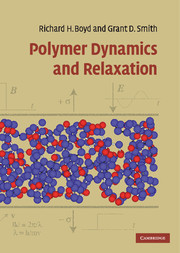Book contents
- Frontmatter
- Contents
- Preface
- Part I Methodology
- 1 Mechanical relaxation
- 2 Dielectric relaxation
- 3 NMR spectroscopy
- 4 Dynamic neutron scattering
- 5 Molecular dynamics (MD) simulations of amorphous polymers
- Part II Amorphous polymers
- Part III Complex systems
- Appendix AI The Rouse model
- Appendix AII Site models for localized relaxation
- Index
- References
5 - Molecular dynamics (MD) simulations of amorphous polymers
Published online by Cambridge University Press: 10 November 2009
- Frontmatter
- Contents
- Preface
- Part I Methodology
- 1 Mechanical relaxation
- 2 Dielectric relaxation
- 3 NMR spectroscopy
- 4 Dynamic neutron scattering
- 5 Molecular dynamics (MD) simulations of amorphous polymers
- Part II Amorphous polymers
- Part III Complex systems
- Appendix AI The Rouse model
- Appendix AII Site models for localized relaxation
- Index
- References
Summary
Atomistic MD simulations are “computer experiments” in which realistic trajectories of the time dependent positions of atoms that make up the simulated material are generated. From these simulations time correlation functions directly associated with relaxation processes of interest can be determined. Hence, MD simulations are literally applied statistical mechanics. MD simulations of amorphous polymers provide a molecular level picture of their structure and dynamics and thereby insight into relaxation mechanisms not available from experiments. The simulator can also explore relaxation mechanisms by performing parametric investigations of the role of polymer structure and energetics (e.g., rotational energy barriers) on relaxations that cannot be mimicked experimentally. Perhaps most importantly, synergistic relationships between simulators and experimentalists can, as demonstrated throughout this book, result in new insights into polymer dynamics and relaxation processes not accessible to either approach alone. This chapter is intended to introduce the non-expert to the concepts, applications, and limitations of atomistic MD simulations of bulk amorphous polymers, particularly with regard to the investigation of polymer dynamics and relaxation processes. A more detailed description of MD simulation methods can be found in several excellent textbooks [1, 2] and compilations [3–6].
A brief history of atomistic MD simulations of amorphous polymers
MD simulations were first applied to biological macromolecules (proteins) in the 1970s [7, 8], motivated by efforts to understand single-molecule folding. Shortly thereafter the method was applied to the study of the dynamics of a single synthetic polymer chain (poly(ethylene)) [9].
Information
- Type
- Chapter
- Information
- Polymer Dynamics and Relaxation , pp. 70 - 80Publisher: Cambridge University PressPrint publication year: 2007
